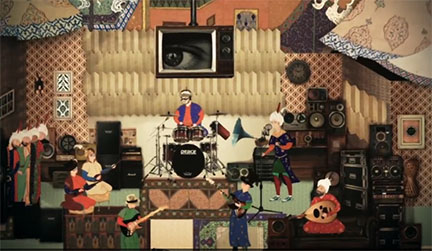
Rumi Rocks, literally. Check out this Iranian video…
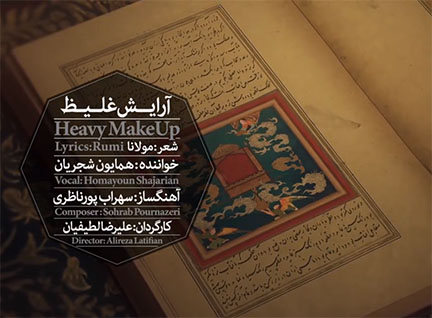
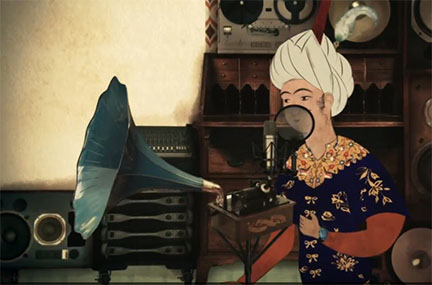

by Kathryn Zyskowski, Cultural Anthropology
Click here to read the five articles and interviews with the authors.
This collection gathers together five articles previously published in Cultural Anthropology, by Naveeda Khan, Hayder Al-Mohammad, Carolyn Rouse and Janet Hoskins, Kenneth George, and Arzoo Osanloo. The collection also includes interviews with the authors, who reflect on their work, as well a commentary on the whole collection from Charles Hirschkind. The articles engage with everyday aspects of living, negotiating, and constructing the world among contemporary Muslims. Moving beyond a focus on the aesthetics of dress, gender relations, or the text in Islam, the collection crosses national boundaries and thematic areas, touching on the immense diversity of nations, peoples, languages, and ideas that fall under the category of Islam. A broad array of ethnographic material is included in the collection: gathering to eat soul food in Los Angeles, navigating a kidnapping in post-invasion Iraq, a child’s relationship to a jinn (spirit/ghost) during sectarian violence in Karachi, discourses around justice in media and conversation surrounding a young man’s death sentence in Iran, and debates about the production of Islamic art in Indonesia.
Continue reading Everyday Islam
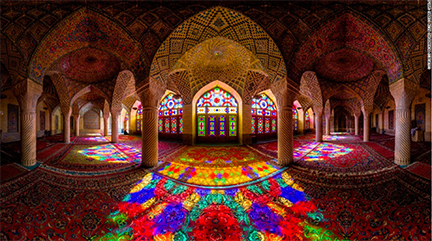
Iranian photographer Mohammad Reza Domri Ganji has compiled a beautiful portfolio of images taken inside landmarks like the Nasir al-mulk Mosque, in Shiraz, Iran.
A set of extraordinary photographs of mosques in Iran by Mohammad Reza Domri Ganji is available on the web. It is well worth checking out. More of his photographs of Iranian mosques can be found here.
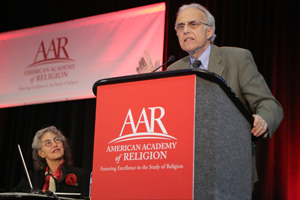
The following is an excerpt from the 2013 Presidential Address (“Islam in the Public Square”) of John Esposito for the American Academy of Religion. His entire talk is free to read online here.
The response of colleagues and family to my chosen career was interesting: Why study Islam, they asked. When I began to speak publicly, both Muslims and Christians asked why I studied Islam, but they had very different agendas in their mind. The best comment I heard was “You’ll never get a job!†At that time I was a young Catholic theologian teaching scripture and theology, and there would always be theology and religion departments.
When I was looking for a job in 1972, only one job advertised was narrowly in Islamic Studies, and the other was in World Religions at the College of the Holy Cross. When interviewed by the incoming chair at Holy Cross, I noted that Hinduism and Buddhism were my minors (in addition to an MA in theology) and that my major was Islam. He pointedly answered, “We are not looking for somebody in Islam,†and even worse, he said, “I prefer somebody in Japanese and Chinese.â€
Training in Islam was totally absent for the military and foreign service officers. And not only that, our foreign service officers in the field were not encouraged to look at religion. When the Iranian Revolution came along, a friend who had been in the embassy said that there was no contact with the ulama, no going into the universities and dealing with faculty or the students in Islamic studies. Indeed, when you talked to analysts in the field reporting back to Washington or consultants on risk assessment in countries, they never looked at the religion factor. And so when Iran came along, people saw it as an epi-phenomenon. Continue reading Islam in the Public Square
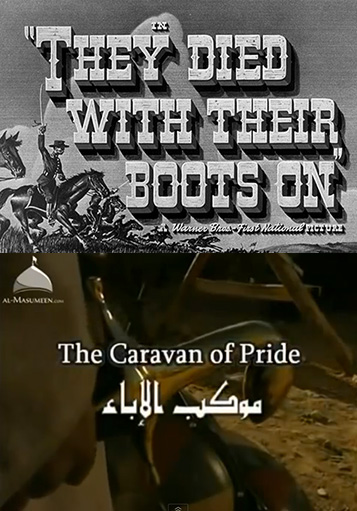
When I was young and impressionable, one of my favorite movies was They Died with their Boots On, the Errol Flynn movie about Custer’s last stand. There was Flynn/Custer with his sword raised out in front of his troops heading for the savage Indians. Had it been a fair fight, of course he would have won, but he stood his ground and was the last man standing. Watching this film recently, apart from the totally ahistorical plot of the made-for-Hollywood battle scene, I wonder how many horses were maimed from the trip wires. In a sense Flynn represented a hero against impossible odds, but in another it perpetuated the notion of the white man’s manifest destiny at the expense of the savage “red man.” I doubt it inspired any sarsparilla party types to go out and shoot any Indians, but it certainly reinforced a cultural bias that remains to this day.
I recently came across a film about the death of Husayn, the Prophet Muhammad’s grandson, at Karbala. This comes in Arabic and Urdu versions and is entitled “The Caravan of Pride” (موكب الاباء). Like the Flynn film, the bias in the film is evident from the start. This is a film highlighting the conservative Shi’a view of an evil and crazed Yazid. Watching the film creates sympathy for the tragic death of Husayn and his followers at the same time that it denigrates the incoming Umayyad caliphs as heretics. It is easy to forget that the event taking place happened in 61 AH/680 CE, before there were any of the Sunni law schools and five years before Abd al-Malik became caliph and authorized a new edition of the Qur’an. Continue reading They died with their sandals on
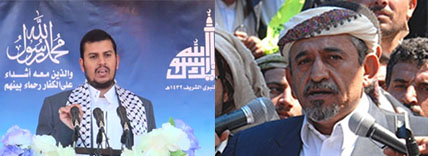
Abd al-Malik al-Huthi, left; Hashid Shaykh Sadiq al-Ahmar, right
by Abdullah Hamidaddin, al-Arabiyya Online, February 8, 2014
Framing matters. It shapes the way we react to a story. It focuses our attention to some details and distracts us from others. It connects a story to another set of stories, and separates it from others. Framing can make a story relevant or irrelevant. Ideally framing would be made through a serious process of observation and analysis. But more than often it is guided by the interests of those framing or their audiences.
Sometimes writers lack the sophistication to see the complexity of the world, so they select simple frames. Other times politicians see that a certain frame serves their interests more than another. Thus they only hear stories framed in their preferred way.
Sticking to Nonsense
I am saying this because of the ways the conflicts in the Middle East are framed as a Sunni/Shiite conflict. And I keep asking myself; why this insistence on retaining such a superficial way of analyzing the region and its conflicts? Why insisting on reincarnating Huntington’s clash of civilization thesis albeit in a ‘clash of sects’ variety? Continue reading Yemen’s Houthi-Ahmar sectarian framing
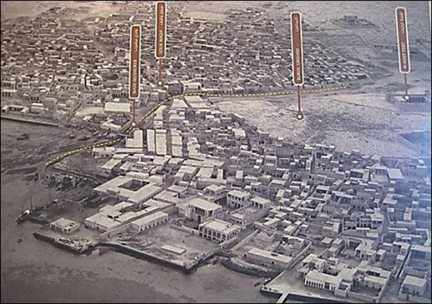
Urban structure of Doha until the 1960s; Source: Scharfenort 2012 (Exhibition in Msheireb Enrichment Center)
The second issue of the new journal Arabian Humanities, with selections in both English and French, is now available online here.
The table of contents is reproduced below:
Juliette Honvault
Éditorial
Villes et dynamiques urbaines en péninsule Arabique
Cities and Urban Dynamics in the Arabian Peninsula
Claire Beaugrand, Amélie Le Renard et Roman Stadnicki
Au-delà de la Skyline : des villes en transformation dans la péninsule Arabique [Texte intégral]
Beyond the Skyline: Cities in Transformation in the Arabian Peninsula [Texte intégral | traduction]
Nelida Fuccaro
Preface: Urban Studies in the Arabian Peninsula: 6 Thoughts on the Field [Texte intégral]
Préface : Les études urbaines en péninsule Arabique
1. Croissances, politiques et projets
Growth paths, politics and projects
Brigitte Dumortier
Ras al‑Khaïmah, l’essor récent d’une ville moyenne du Golfe [Texte intégral]
Ras al‑Khaimah : the recent dynamics of a middle size city of the Arab‑Persian Gulf
Steffen Wippel
Développement et fragmentation d’une ville moyenne en cours de mondialisation : le cas de Salalah (Oman) [Texte intégral]
Development and Fragmentation of a Globalizing Secondary City: The Case of Salalah (Oman)
Sebastian Maisel
The Transformation of ‘Unayza: Where is the “Paris of Najd†today? [Texte intégral]
La transformation de ‘Unayza : où en est le « Paris du Najd » ?
Philippe Cadène
Koweït City : planification urbaine et stratégie régionale [Texte intégral]
Kuwait City: Urban Planning and Regional Strategy Continue reading Arabian Humanities Online
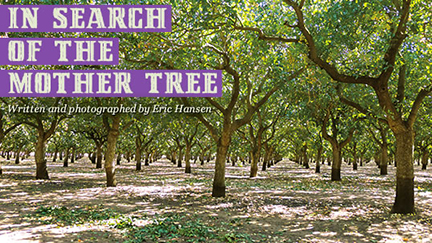
In the current issue of ARAMCO World, which is available free online, there is an interesting article on how Iranian pistacios came to California. Click here for the full article. I attach a teaser below…
In 1957, a small experimental orchard in Chico, California distributed to commercial nut-growers a promising new variety of pistachio tree from Iran, called Kerman.
The United States Department of Agriculture wanted to see how these Kerman trees might perform in the richly fertile Central Valley of California.
By 2013, the Kerman had created a billion-dollar agricultural industry, and what was once a delicacy was a long way toward becoming a common household snack. University of California pistachio specialist Louise Ferguson calls the California Kerman pistachio tree “the single most successful plant introduction of the 20th century.â€